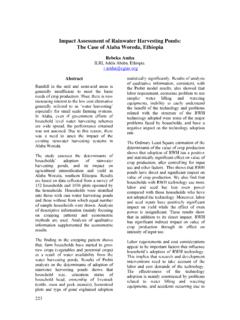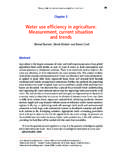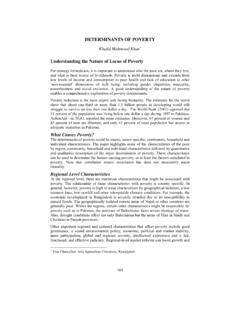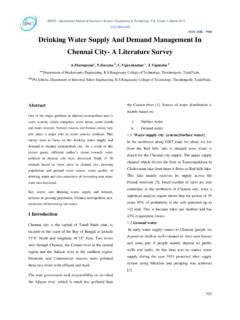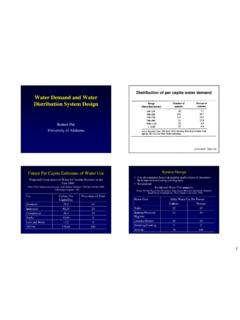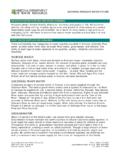Transcription of India’s Water Supply and Demand from 2025-2050: Business ...
1 India's Water Supply and Demand from 2025-2050: Business - as- Usual Scenario and Issues 1. Upali A. Amarasinghe, 1 Tushaar Shah, and 1. International Water Management Institute, New Delhi, India 2. Consultant, Bangalore, India Introduction For many reasons, India and China have had a central place in global food and Water Supply and Demand projections. First, constituting more than one-third of the world's population, they are the two most populous countries in the world. And, by the middle of this century they need to feed 700 million more people.
2 Second, both countries have huge economies. Their economic growth in the recent decades since the 1970s in China and since the 1980s in India has been remarkable. With booming economies, people's expenditure patterns are changing and so do their lifestyles. Rapid urbanization is also adding fuel to these changes. As a result, food consumption patterns are changing changes a traditional country like India would not have imagined a few decades ago. The changing food consumption patterns are so significant that they have a considerable impact on future food and Water demands.
3 Third, and perhaps the most critical, is that both countries have significant spatial mismatches between their populations and their Water resources; less Water is available in places where more people live and much of the food is grown. Thus, the manner in which India and China meet their increasing food and Water demands have been the major focus of many recent food and Water Demand projections both at the global scale (IWMI 2000; Rijsberman 2000; Rosegrant et al. 2002; Seckler et ) and at the national scale (Bhalla and Hazelle 1999; Dyson and Hanchate 2000; GOI 1999).
4 On account of the rapid economic and demographic changes, the food and Water Demand projections of India and China need regular updating. For the base year, many recent projection studies used information relevant to the late 1980s and up to the early 1990s. One such study is the 1998 Water Demand projections of the National Commission of Integrated Water Resources Development (NCIWRD) (GOI 1999), which considered a blueprint for Water resources management and planning in India. For the base year, the NCIWRD projections used data relevant to 1993-1994, while future projections were derived from trends relevant to the 1980s.
5 However, many changes over the past decade, which were unforeseen at the time of the study, have affected the Demand projections. In particular, for example, changes due to the economic liberalization of the early 1990s in India are only visible now. Today, India has an unprecedented economic growth (there has been an annual economic 23. U. A. Amarasinghe, T. Shah and B. K. Anand growth of 8 % to 9 % in the last few years). This kind of growth has rapidly changed, certain food and Water Demand drivers that are endogenous to India, such as food consumption and land use patterns, and that are exogenous to India, such as world food trade.
6 Therefore, in this context, many of the past food and Water Demand projections need to be reassessed. This paper revisits India's Water future assessment from 2025 - 2050. It incorporates the recent changes in food- and Water -related drivers in the Supply and Demand assessment and also analyzes the sensitivity of future projections to changes in these Demand drivers. This paper uses the PODIUMSIM model for projecting India's Water future. The PODIUMSIM (the Policy Dialogue Model) methodology is a tool for simulating alternative scenarios of Water future with respect to variations in the food and Water Demand drivers (see Annex 1 for more details).
7 This analysis has the benefit of using the latest data on demography, by using the 2001 census (GOI 2003); on food consumption patterns from the latest consumption and expenditure surveys (GOI 2001); and on land use and production patterns from recent agriculture surveys (GOI 2004a 2004b). The major objectives of this paper are to: assess the current status of food and Water Supply and Demand in Indian river basins;. project the Water future of India and assess the implications of the Water Demand projections on river basins; and assess the sensitivity of food and Water Demand projections to changes in the key Demand drivers.
8 The rest of the paper is organized into four sections. The next (second) section presents the methodology and descriptions of the data used for simulating Water Demand in this paper. The third section describes the current situation of food and Water accounting in India and her river basins. The fourth section relates the projected Water future of India during the period 2025 to 2050. The BAU scenario, which describes the Business -as-usual scenario Water future, is mainly based on the recent trends of the food and Water Demand drivers.
9 The final projection of Water future is very sensitive to many of these drivers. Therefore, in the fifth section, we assess the sensitivity of the Water future projections with respect to changes in the Demand drivers. We conclude the paper with a discussion of policy implications. Data and Methodology Methodology The PODIUMSIM simulates the Water future scenarios of this paper. The model explores the technical, social and economic aspects of alternative scenarios of future Water Demand and Supply at the sub-national level (see Annex 1 for details of the model).
10 The sub-national units could either be the administrative boundaries such as states or hydro-ecological regions, or the hydrological boundaries such as river basins. The river basins are the units of assessment for this paper. 24. India's Water Supply and Demand from 2025-2050. The PODIUMSIM model has four major components: crop Demand , crop production, Water Demand , and Water accounting. The four components are assessed at various temporal and spatial scales (Table 1). Table 1. Spatial and temporal scale improvements of different components.
